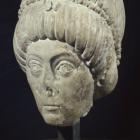Byzantine sculptor, Female head, possibly that of Theodora
Byzantine sculptor, Female head, possibly that of Theodora, marble, circa 540 (inv. n. 755)
The work was found in 1846, after being disinterred from a depth of around 80 cm in the vicinity of via San Primo in Milan: the discovery at such a shallow depth and in the area occupied by the city walls, allows for the hypothesis that it may have been used as building material for the city's fortifications. The sculpture represents the effigy of a mature woman, with high cheek bones, wide open eyes and a perfectly shaped face. Upon her head she wears a high bonnet richly decorated with a pearl diadem, with at its centre an oval gem. The exceptional quality of this portrait, renders it both one of the west's most significant examples of Byzantine art and very difficult to classify. Often identified as being a portrait of Empress Theodora (517-584), wife of Justinian, or that of Justina, mother of Valentinian II, the work balances an impersonal evocation of majesty with a marked naturalism, as a result of the association between the individual rendering of her features and an essential approach to volumes.








